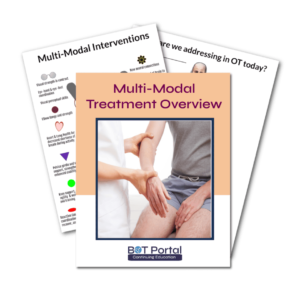Description
Supporting Structure of OT Practice
Occupational therapy (OT) practice is supported by a well-structured framework that ensures effective and individualized care. This framework includes a combination of theories, models, principles, and guidelines that help occupational therapists (OTs) provide high-quality services. Understanding the supporting structure of OT practice is essential for comprehending how OTs help individuals improve their daily functioning and quality of life.
Theoretical Foundations
OT practice is grounded in various theories that explain how people engage in activities and how these activities impact their health and well-being. These theories include:
- Occupational Behavior Theory: Emphasizes the importance of meaningful activities in promoting health.
- Developmental Theories: Focus on how people grow and change throughout their lives, influencing how OTs address issues at different life stages.
- Cognitive-Behavioral Theory: Explains how thoughts and behaviors affect one’s ability to perform activities, guiding interventions to change maladaptive patterns.
Practice Models
Models provide a structured way to apply theoretical concepts in practice. Some commonly used models in OT include:
- Model of Human Occupation (MOHO): Focuses on understanding the motivation (volition), routines (habituation), and physical and mental abilities (performance capacity) that influence how people engage in activities.
- Canadian Model of Occupational Performance and Engagement (CMOP-E): Highlights the interaction between the person, their environment, and their occupations (activities), emphasizing client-centered care.
- Person-Environment-Occupation (PEO) Model: Examines the dynamic relationship between individuals, their environments, and the activities they perform, guiding interventions to enhance this fit.
Principles and Guidelines
OT practice is guided by a set of principles and ethical guidelines that ensure care is safe, effective, and respectful of clients’ rights. These principles include:
- Client-Centered Practice: Placing the client’s needs, goals, and preferences at the center of all interventions.
- Evidence-Based Practice: Using the best available research evidence to inform treatment decisions.
- Holistic Approach: Considering the whole person, including their physical, emotional, social, and environmental needs, rather than just focusing on a specific problem or diagnosis.
Professional Standards
OTs adhere to professional standards set by regulatory bodies and professional organizations. These standards ensure that therapists have the necessary education, skills, and ethical grounding to practice effectively. Continuous professional development is also encouraged to keep up with advancements in the field.
Multidisciplinary Collaboration
OTs often work within multidisciplinary teams that may include doctors, nurses, physical therapists, speech therapists, and social workers. This collaboration ensures comprehensive care, addressing all aspects of a person’s health and well-being.
The supporting structure of OT practice is a robust framework that combines theoretical foundations, practice models, guiding principles, professional standards, and multidisciplinary collaboration. This framework enables occupational therapists to provide personalized, effective, and holistic care, helping individuals improve their ability to perform daily activities and enhance their overall quality of life.




